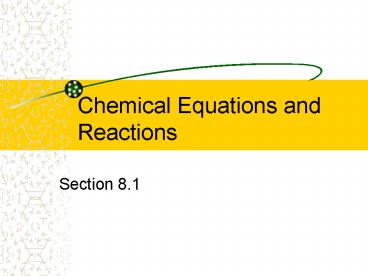Chemical Equations and Reactions - PowerPoint PPT Presentation
1 / 12
Title:
Chemical Equations and Reactions
Description:
Production of light/color change. Change in state ... Zn(s) 2HCl(aq) -- H2(g) ZnCl2(aq) Let's balance some equations ... (aq) ---- 3 Zn(s) 2 AlCl3 ... – PowerPoint PPT presentation
Number of Views:17
Avg rating:3.0/5.0
Title: Chemical Equations and Reactions
1
Chemical Equations and Reactions
- Section 8.1
2
What is a chemical reaction?
- Any change where a new chemical is formed.
- Indications of a chemical reaction
- Change in temperature
- Production of light/color change
- Change in state
3
Changes in State
- Not all changes in state indicate a chemical
reaction. When water melts it is just a physical
change. - When two liquids are mixed and a solid is formed
that solid is called a precipitate.
4
What is a chemical equation?
- Chemical equations represent chemical reactions
- They
- Identify reactants and products
- Contain the correct chemical formulas
- Satisfy the Law of Conservation of Mass.
Coefficients are used to tell how many of each
chemical is present.
5
Types of chemical equations
- Word Equations
- methane oxygen --gt carbon dioxide water
- Formula Equations
- CH4(g) 2O2(g) --gt CO2(g) 2H2O(g)
6
State Symbols
- State symbols - subscripted after each element or
compound. - (s) - Solid
- (l) - Liquid
- (g) - Gas
- (aq) - Aqueous. This means that a substance is
dissolved in water.
7
Other Symbols
- Yields sign - arrow that separates reactants from
products. - Triangle above yields sign - reactants must be
heated. - Up arrow- a gas is formed
- Down arrow - a precipitate is formed
- lt--------gt - reversible reaction
8
Law of Conservation of Mass
- Matter cannot be created nor destroyed in a
chemical reaction so we have to have the same
number of each element on both sides of the
equation. - This is done by balancing the equation with
coefficients. - Zn(s) 2HCl(aq) --gt H2(g) ZnCl2(aq)
9
Lets balance some equations
- The rusting of Iron
- Fe O2 ----gt Fe2O3
4 Fe 3 O2 ----gt 2 Fe2O3
- Combustion of octane in an engine
- C8H18 O2 ----gt H2O CO2
2 C8H18 25 O2 ----gt 18 H2O 16 CO2
10
The Diatomic Elements
- There are seven diatomic elements. They are never
found as individual atoms but are bonded as a
pair of atoms - H2, N2, O2, F2, Cl2, Br2, I2
- You must memorize these!
11
Lets write some equations
- Calcium reacts with sulfur to produce solid
calcium sulfide. - Ca (s) S (s) ----gt CaS (s)
- Hydrogen reacts with fluorine to produce hydrogen
fluoride gas. - H2 (g) F2 (g) ----gt 2 HF (g)
12
Here is another
- Aluminum reacts with a solution of zinc chloride
to produce zinc and aqueous aluminum chloride - 2 Al(s) 3 ZnCl2(aq) ----gt 3 Zn(s) 2 AlCl3(aq)































